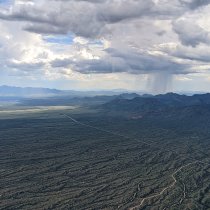Using NEON Data to Inform a Changing World
December 6, 2018
By Sharon Collinge, Past Observatory Director and Chief Scientist
Two major reports recently came out that got me thinking about our changing planet and the role of NEON in monitoring those changes.
The 4th National Climate Assessment, produced by the U.S. Global Change Research Program (USGCRP) every four years by congressional mandate, analyzes current trends in global climate and ecosystem change and forecasts how these changes will impact our environment and society over the next 25 to 100 years.
The Second State of the Carbon Cycle Report (SOCCR2) looks more specifically at carbon fluxes between the atmosphere and various carbon sinks, including water, soil and vegetation in different ecosystems and under different land use scenarios. The goal of this report, which is produced every ten years, is to better understand sources of carbon emissions and how the carbon storage potential of different carbon sinks is changing over time.
Both of these reports are geared towards informing policy makers, who need to understand how our climate and ecosystems are changing in order to make decisions that protect both humans and our environment. These reports make it clear that the earth is undergoing massive and rapid changes, that these changes are largely caused by human activity, and that they will have a major impact on our health, economy and global security in the years and decades to come. Accurate forecasts and models are desperately needed to drive better decision making for land use, economic development and natural resource management that balance the needs of today against the needs and rights of future generations.
Our climate and earth system models have gotten much better over the years, but there is still a lot of room for improvement. Having data that are collected in a standardized manner over large spatial and temporal extents will help the scientific community create models that are better able to predict the impact of current trends and the potential effects of different policy and land use decisions.
The NEON project is poised to provide exactly the kind of data that USGCRP and other groups will need to create the next generation of climate and earth system models.
Filling in Data Gaps for Tomorrow's Environmental Models
SOCCR2 identifies four key opportunities for improving climate models and forecasts: expansions in environmental monitoring, syntheses of available observations, improvements in assessment tools and models, and extension of existing modeling capabilities. While their recommendations were specific to the problem of measuring and forecasting changes in carbon flux, I believe they can be applied broadly across all aspects of ecological data collection and modeling. The NEON project is well positioned to enable the research community to address these knowledge gaps.
- Expansions in environmental monitoring: The NEON project is complex and comprehensive, designed to collect standardized climate and earth system data on a continental scale across a 30-year time horizon. Our sites have been carefully selected to represent both terrestrial and aquatic environments across 20 ecoclimate zones in North America, including landscapes with a wide range of human influences. Our broad geographic and temporal scope will help researchers fill in many of the gaps we currently have in our earth system models, providing data to help us better understand how ecosystems are changing and how human activities may impact those ecosystems.
- Synthesis of available observations: NEON provides a rich repository that can accelerate efforts to synthesize environmental data from a variety of sources, including the Long-Term Ecological Research Network (LTER), the Critical Zone Observatory (CZO), AmeriFlux and GLEON. We are working within a "network of networks" to identify ways in which data produced by different organizations can be used together to answer complex questions around climate and ecosystem change, earth system structure and function, carbon and energy fluxes, and other critical topics in ecology. NEON data are also being used to bridge scale gaps and enable scientists to synthesize data from field, remote sensing and satellite observations.
- Improvements in assessment tools and modeling: The NEON project has been at the forefront of developing methods to ensure data accuracy and validity. All of our instruments are regularly maintained and calibrated using international best practices to ensure that data are comparable from site to site and year to year. That's why the recent MALIBU project used NEON data as a reference set for calibrating drones that will be used to validate satellite data. As monitoring methods and technologies improve, we will continue to strive for improved accuracy, precision and reliability in our data products.
- Extension of existing modeling capabilities: NEON data are already being used to support the development of better models for earth systems and climate change. NEON provides a source of highly accurate and comparable data products across a range of ecosystems that can be used to fill in data gaps and improve the predictive power of our environmental models. NEON data will also provide a reliable and consistent record over the 30-year life of the project that can be used to test, evaluate and refine environmental models over time.
NEON and the Future of Earth System Modeling
I am excited by the opportunities that I see for the use of NEON data in environmental modeling in the future, and the ways in which our data are already being used. For example, a recent paper used NEON data to explore the connections between mineral content and carbon storage potential in soils. This and other studies are using NEON data to refine our understanding of carbon flux and other ecological processes, which will in turn help to improve our climate modeling abilities.
While the NEON data products are too new to have been used in the federal reports released last month, it is my hope that NEON data will have a large role to play in the next iteration of these studies. By the time the 2022 National Climate Assessment and 2028 SOCCR come out, the NEON project will have a large repository of climate and ecosystem data that can be used to support their analyses.
In the meantime, researchers here at NEON are continuing to play a critical role in driving discussions around environmental monitoring, data synthesis and development of improved environmental models. In April 2019, NEON and the National Center for Atmospheric Research (NCAR) are cohosting an NSF-sponsored workshop: Predicting Life in the Earth System – Linking the Geosciences and Ecology. This workshop will bring together ecologists and atmospheric scientists to discuss ways that the disciplines can work together to improve predictive modeling by synthesizing data and insights from the geosciences and terrestrial biology. We are also continuing ongoing discussions and collaboration with our colleagues at LTER, CZO, AmeriFlux, the newly formed Ecological Forecasting Initiative and other ecological networks. As the science community works together to improve our ecological modeling and forecasting abilities, the NEON project will continue to play a vital role.
The National Ecological Observatory Network is a continental-scale observation facility of the National Science Foundation, operated by Battelle.



